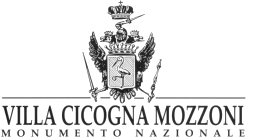THE MAIN COURT-YARD
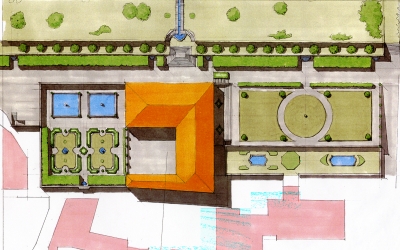
Map of the house and formal garden
The palace itself shows two construction phases, as can be gathered from an accurate study of the original plans. Pre-existent walls had been partly used (the front is not symmetric with the building, the arcades are not equally deep etc.); but the characteristics of the building and the decorations are in the same style. It can therefore be assumed that the stonework (masonry) and the painting on the front, of the arcades, of the staircase and partly of the interior have all been executed between 1550 and 1570 AD. The fresco can not have been painted before 1560, because a coat of arms belonging to Pius IV Medici di Marignano appears in the main courtyard.
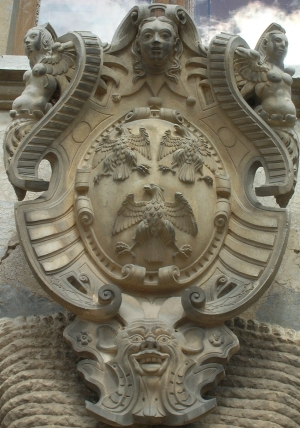
Mozzonis' coat of arms
The big arch-way made of square stone, similar to the one of palazzo Cicogna in Milan, supports the marble coat of arms showing the three eagles of the Mozzoni. Whereas in the interior there are numerous coats of arms of the Cicogna and a few composed of both insignia: the stork on top, the eagles below. The courtyard has only three sides; the fourth side opens a beautiful view on the “house-garden”. The walls of the court-yard and the arcades are decorated with vivacious series of paintings; the intersection between the windows of the first two sides show male and female figures and below the window-sills a heraldic insignia which might allow to identify these figures. The big figures and the medallions, naturally faded during the past centuries, most probably represent the owners and the Sforza, Dukes of Milan, who often used to hunt in Bisuschio. The decoration on the inside of the arcades, showing hunting, farming and fishing, are an interesting pictorial document of the life on the estates of the Mozzoni. All these frescoes are normally attributed to the school after the brothers Campi from Cremona. The paintings are of a good level and of pure renaissance taste. These frescoes were discovered only around 1800 AD, because during the plague in the 17 Th. century they had been covered by whitewash for hygienic reasons. Only after starting to remove the plaster by help of hammers, traces of which can be seen on the left side the frescoes were discovered and laid free.
THE STAIRCASE
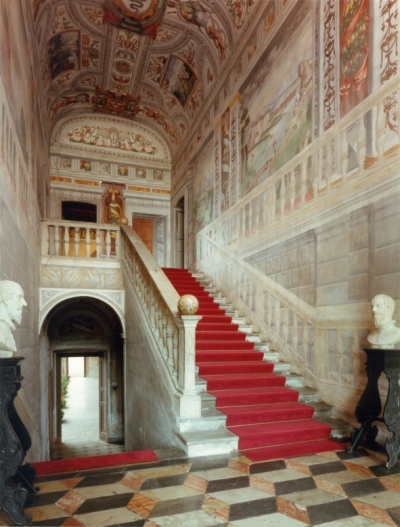
The staircase (Photo by Vincent Berg)
From the main courtyard there is the entry to the staircase, the walls and vault of which are entirely covered by paintings. On the first landing are two marble busts of Augusto and Francesco Mozzoni. On the top part of the staircase, above the painted balustrade, is a pictorial panorama of the surrounding landscape. The artists have of course idealized these views, but one can recognize the hill above Besano and the castle of Cuasso al Monte, now decayed. Between the frescoes are original festoons of fruit, flowers and leaves symbolizing the products of the surrounding lands. The imagination of the artists has created on the beautiful ceiling small views and idyllic settings, framed by arabesques. The coats of arms depicted in the staircase and the courtyard belong to the wives of the Mozzonis' eldest sons (Visconti di Pogliano, Bossi, and Arcimboldi, e Mozzoni).
THE LIBRARY
Originally this room was used for entertainment. Music was played; the minstrels entertained the owners and their guests with songs, poetry music and dances. In fact, on the festoons running around the whole room amoretti hold the words “AD DULCES PARNASI NUMINA CANTUS VENIMUS”. Furthermore one can see the nine Muses, daughters of Zeus and Mnemosis i.e. Calliope Muse of elegy, Clio Muse of epic chant, Erato Muse of love-poetry, Terpsicore Muse of coral lyrics, Melpomene Muse of tragedy, Euterpe Muse of lyric chant and of the flute, Polymnis Muse of dance and old chant, Urania Muse of astronomic and didactic epics. There is also Apollo (Dionisos Musagetes) who in mythology leads the Muses who dance and sing with him, especially during the feasts and banquets of the gods of the Olympus
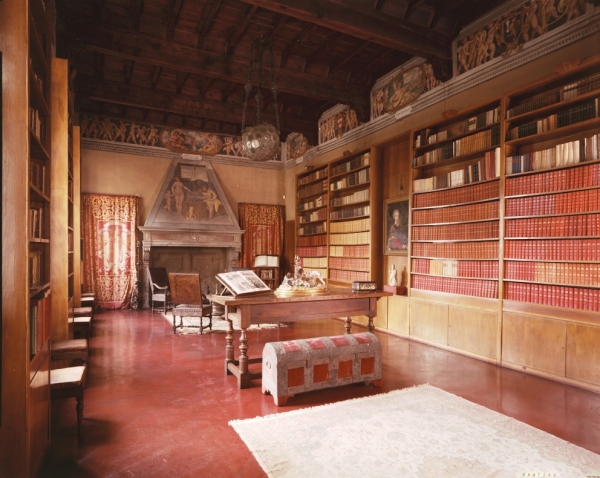
The library (Photo by Vincent Berg)
On the upper part of the fireplace a representation of Vulcanus and Venus. Later it was decided to use this room as library, in order to take care of the various thousands of volumes collected by former generations and the present owners.
Especially interesting are enormous fireplace, the big tailor’s table dating from 1670, a large wooden trunk covered with metal and velvet dating back to the 14Th. Century, a Venetian chandelier from the 16Th. Century and the wooden ceiling.
FIRST ROOM
In the centre an Austrian fortepiano dated 1798, the walls covered with painted trophies and musical instruments. On the doors lacquered in red is the image in gold of a stork, heraldic animal of the present owners.
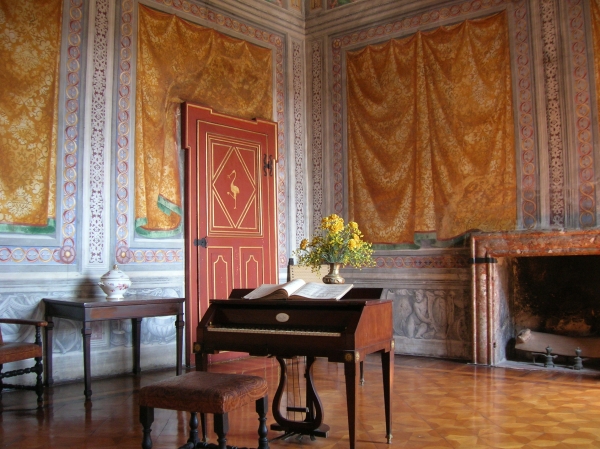
Fortepiano room
Further note the magnificent original coffer ceiling with gilded fittings, which up to now have neither been touched nor restored. Some frescoes on the walls of this and the two following rooms are velvet draperies executed up to the last detail, without even forgetting to paint the nails holding the cloth.
SECOND ROOM
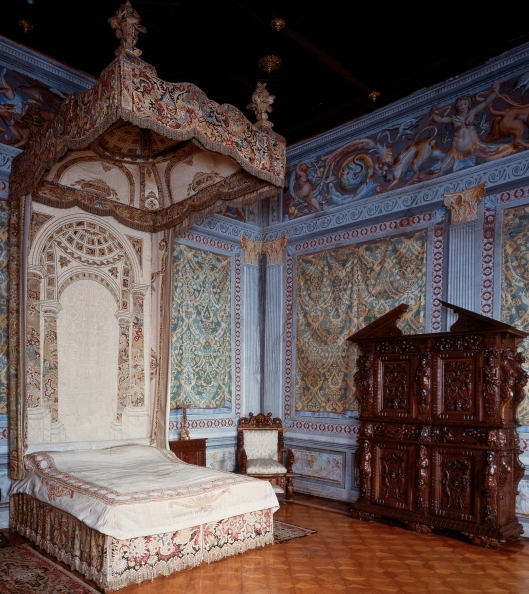
Bed with a vaulted canopy from the XVIII century (Photo by Vincent Berg)
Beautiful twin bed with a vaulted canopy from the 18 Th. century named “della Cittrona”. The silk coverings of the outer screening of the bed as well as of the canopy are embroidered in petit point. Of great value is the late-baroque furniture made of nut wood. In the corner a statue representing a woman with child. A festoon with frescoes of animals and wooden ceiling with gilded fittings.
THIRD ROOM
In this room also velvet draperies executed in fresco. In one corner a fresco reproduced on canvas dated from 1534, representing St. Rochus, patron of the plague-affected, showing the wound on his groin; this picture is attributed to the school of Borgognone.
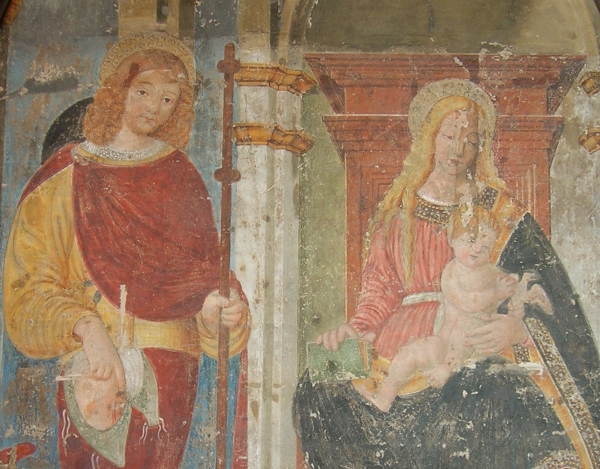
St. Rochus
On the writing desk, which can be transformed into a table, two candlesticks in gilded bronze. A double armchair from the 17 Th. century and armchairs covered with two colours leather. Next to a wall an Austrian chest from the 19 Th. century. Remarkable the baked tiles coloured with ox-blood.
WOMENS' QUARTER
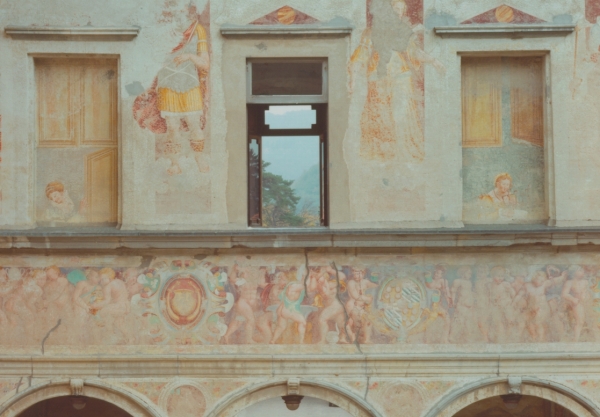
Frescoes outside (Photo by Vincent Berg)
From the outside of the building three windows can be seen from which the women could observe the happenings in the outer courtyard.
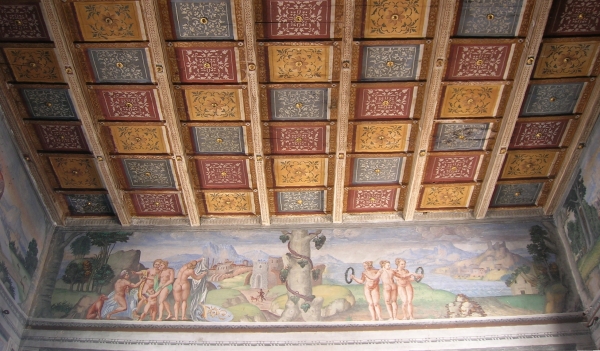
Ceiling and frieze
In the first room the fresco near the ceiling shows fauns, dwarfs the three goddess of beauty, amoretti on a two-wheeled cart drawn by lions. Ceiling with painted quadrangles.
SECOND ROOM
On top fantastical representation of women, animals, dragons and amoretti.
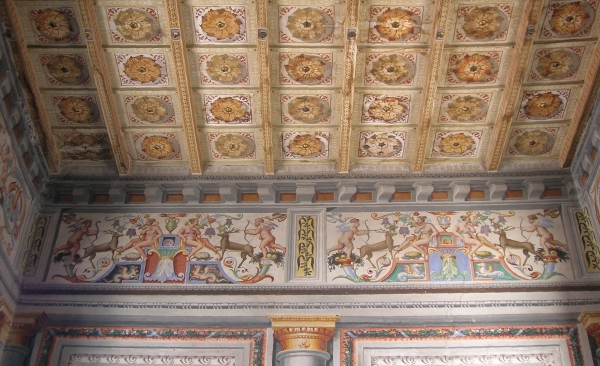
Ceiling and frieze
Beautiful coffered ceiling and in a window-bay an original built-in wardrobe. From an inscription on the drawer below the wardrobe we assume that this was Cecilia Mozzoni’s maiden room.
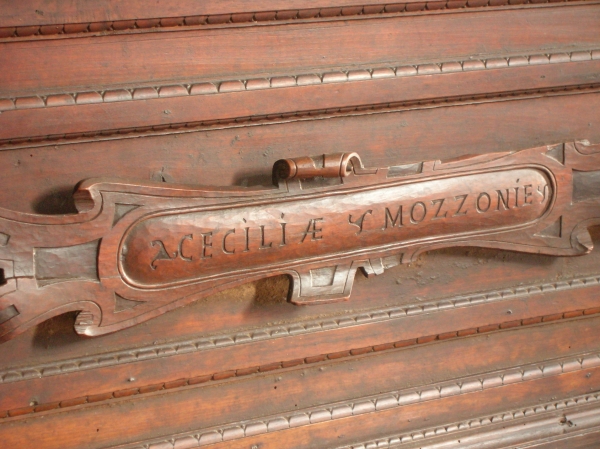
Cecilia Mozzoni lived between 1538 and 1613
THIRD ROOM
Bed with gilded posters (or post) and fabric-covered chairs from the 17 Th. century.
GREEN ROOM
Large walnut wardrobe and a carved kneeling-stool, bed with columns from the XVII Century. From this room beautiful view on the secret and terraced garden looking north.
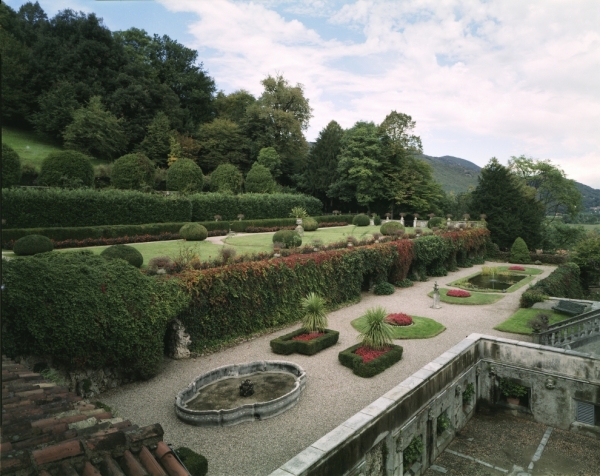
The secret and terraced garden (Photo by Vincent Berg)
RED ROOM
Large bed with panoramic vaulted canopy covered in silk. On the walls two magnificent French gilded dressing-glasses from the 18 Th. century. Please note the ceiling and the stone benches at the side of each window. Beautiful Dutch trumeau from the 16 Th. century. One of the frescoed pilaster strips shows the year 1559 in which the frescoes were executed.
OTHER ROOM
Bed with columns with gilded flames and double writing desk in rosewood, seats are leather from the XVII Century.
LARGE RECEPTION ROOM
This is the most important room of the whole palace. The coffer ceiling is especially elaborate. Over large fireplace of Viggiù stone richly chiselled with representations of arms and tools. Along the walls five portraits representing ancestors of the Cicogna Mozzoni. The lady is Angela Mozzoni, only daughter of the Counts Mozzoni, who married Gian Pietro Cicogna bringing as dowry all possessions of the Mozzoni including the house in Bisuschio.
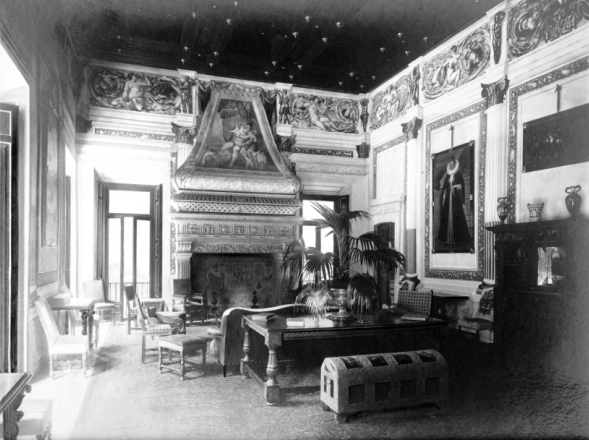
Large reception room in a photo dated 1890
Wooden wardrobe with fine carving from the early 17 Th. century. Along the walls a series of chairs covered with petite-point embroidery and four carved wooden consoles from the 18 Th. century. On the 17 Th. century chest in the background a reproduction of a dog which during a bear-hunt saved the life of a Duke of Milan. In fact, during the baiting, a pack of hounds discovered and attacked a magnificent specimen. The bear defended itself and put almost all hounds out of action. Among the first hunters attracted by the big noise was the Duke of Milan who found himself suddenly face to face with the enraged animal. The dog, already wounded, collected its last energies and leaped at the bear throat. This was sufficient to divert the bear’s attention from the Duke, whom the animal was nearly holding in its claws, and give Agostino Mozzoni the opportunity to kill it. The chronicle of Simonetta reports that the bear weighed full 250 lb. and “damaged three man and killed a dog”. The beast’s fur was stuffed and exposed in the castle of Milan next to an embalmed stag. One of the “damaged” man was certainly Agostino Mozzoni who must have taken part in the hunt and faced the beast discovered by the hounds with spear and sword. This incident was mentioned by the Duke himself in a letter in which he exempts Agostino Mozzoni from certain taxes because of his hospitality and loyalty, as follows: “Intus ursorum venationibus, quas nuper in vicariatu nostro Varisij fecimus ita se prontium in imnibus praebuit ...Agustinus de Mozzonibus de loco Besustij... ut aliqua ex parte satixfaciamus vulnere quod ad urso in ipsis venationibus illatum... etc.” The hound died of its wounds and the grateful Mozzoni had this reproduction made in terracotta and buried the animal in the garden, erecting a small monument, which still can be seen today.
